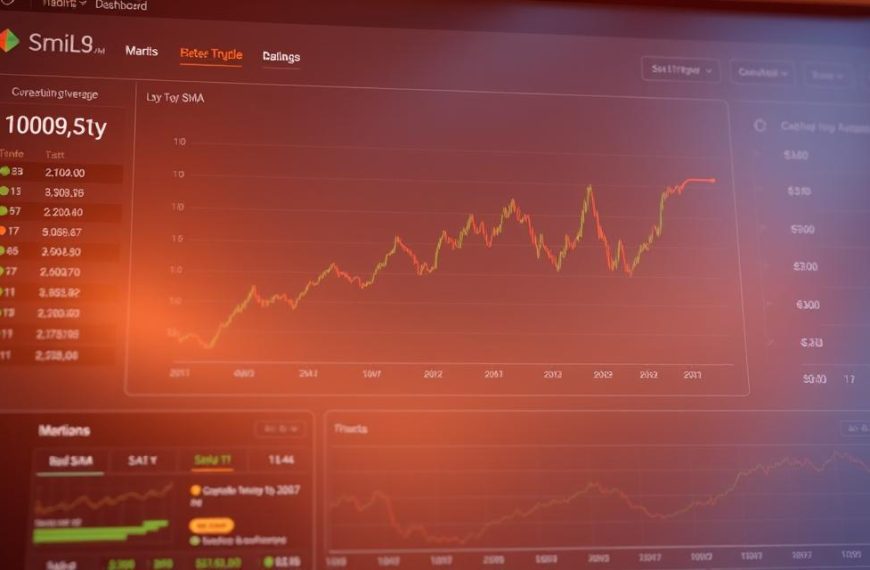Crypto trading pairs are vital for digital asset exchanges. They let investors compare and swap different cryptocurrencies easily. These pairs form the basis of crypto trading platforms1.
Trading pairs show relative values between digital assets. They’re key for advanced trading and growing crypto holdings beyond popular coins2. Understanding these pairs helps investors use complex strategies and diversify their portfolios3.
Bitcoin (BTC) and Ethereum (ETH) are the most common trading pairs. They’re available on many exchanges2. Examples include Bitcoin/Litecoin (BTC/LTC) and Ether/Bitcoin Cash (ETH/BCH)1.
These pairs help compare costs between different cryptocurrencies. They also show relative market strength2. Traders use this info to make smart investment choices and spot arbitrage chances1.
Savvy investors know that grasping crypto pairs is crucial. It helps expand holdings and use advanced trading methods. However, these techniques need careful study and risk management3.
Understanding the Fundamentals of Crypto Trading
Digital asset trading has transformed modern finance. Cryptocurrency markets form a dynamic ecosystem, distinct from traditional financial systems4.
Crypto trading has unique features compared to conventional markets. It allows trading between different digital currencies, creating a complex, interconnected environment5.
The Evolution of Digital Asset Trading
Digital asset trading has undergone remarkable changes. Key developments include:
- Emergence of decentralised exchanges
- Increased institutional interest
- Development of advanced trading platforms
- Enhanced security protocols
Key Components of Cryptocurrency Markets
Successful crypto trading requires understanding several critical components:
- Blockchain technology
- Digital wallets
- Trading pairs
- Liquidity mechanisms
The Role of Trading Pairs in Modern Finance
Trading pairs are central to cryptocurrency transactions. Major pairs like BTC/USDT and ETH/USDC offer stable trading and better liquidity4.
High-volume markets attract traders. These markets provide more predictable price movements and efficient execution5.
The cryptocurrency market represents a new frontier in digital asset trading, offering unprecedented opportunities for innovative investors.
Grasping these basics is vital for navigating the complex world of cryptocurrency markets6.
What is a cryptocurrency pair?
A cryptocurrency pair defines how two digital currencies exchange in crypto markets. It consists of two key parts: the base currency and the quote currency7.
Crypto pairs allow direct exchanges between different digital assets. Major pairs often involve popular cryptocurrencies and fiat currencies8. Common examples include:
- BTC/USD (Bitcoin/US Dollar)
- ETH/EUR (Ethereum/Euro)
- BTC/ETH (Bitcoin/Ethereum)
The base and quote currency relationship shows the relative value of digital assets. ETH/BTC tells you how many Bitcoin units buy one Ethereum9.
This system helps traders grasp pricing dynamics and make smart trading choices7.
Understanding trading pairs is crucial for navigating the complex cryptocurrency marketplace.
When exploring trading pairs, traders must consider several factors:
- Liquidity levels
- Transaction fees
- Market volatility
- Price discovery mechanisms
Stablecoins like USDT, USDC, and BUSD are popular quote currencies. They offer stability in volatile crypto markets7.
Choosing the right trading pairs helps investors improve their strategies. It also aids in managing potential risks effectively8.
The Anatomy of Trading Pairs in Cryptocurrency
Cryptocurrency trading pairs are crucial for digital asset exchanges. They show the relationship between two currencies. These pairs help traders understand market dynamics in digital finance.
Trading pairs have two key parts: base currency and quote currency. The base currency is the main asset traded. The quote currency sets its value.
In a BTC/USDT pair, Bitcoin is the base currency. Tether acts as the quote currency. This pairing helps determine Bitcoin’s value relative to Tether.
Decoding Price Formation
Price formation in crypto pairs involves complex processes. It reflects market sentiment and trading activities. Several key factors influence this process.
- Supply and demand dynamics
- Market liquidity
- Trading volume
- External market influences
Understanding Spread and Liquidity
The spread is the gap between bid and ask prices. It’s vital for understanding trading costs. Liquidity shows how easily an asset can be traded10.
Major pairs like BTC/USDT usually have higher liquidity. This makes them easier to trade than exotic pairs.
Liquidity is the lifeblood of effective cryptocurrency trading.
Traders must analyse spread and liquidity carefully. Narrow spreads suggest efficient markets. Wide spreads may indicate potential trading challenges11.
Popular Trading Pairs in the Crypto Market
Crypto trading centres on pairing digital assets strategically. These pairs form the foundation of digital exchanges, offering diverse investment opportunities12.
Traders often deal with major cryptocurrencies through specific pairs. These pairs provide optimal liquidity and market dynamics. In December 2021, USDT featured in six of the top ten trading pairs12.
- Most Common Bitcoin (BTC) Trading Pairs:
- BTC/ETH
- BTC/DOGE
- BTC/LTC
- BTC/ADA
- BTC/XLM
Stablecoin pairs have become increasingly popular. Pairs like BTC/USDT and ETH/USDC offer better liquidity and stability4. These pairs attract traders looking for predictable market conditions.
- Popular Stablecoin Trading Pairs:
- USDT/BTC
- USDT/ETH
- USDT/DOGE
- DAI/ETH
- DAI/USDC
Fiat currency trading pairs are also crucial. USD/BTC, USD/ETH, and USD/USDT are particularly prominent. Regional currencies like the British pound are gaining popularity in their markets12.
The trading landscape is constantly changing. Volume is shifting towards fiat base pairs and stablecoins. Traders should consider liquidity, volatility, and market trends when choosing their pairs4.
The Significance of Base Currencies
Base currencies are vital in cryptocurrency trading. They form the foundation for digital asset exchanges. Understanding these units is crucial for successful trading strategies.
Bitcoin and Ethereum dominate as base currencies in the crypto world. Their popularity stems from high market cap, strong liquidity, and global recognition. These coins also boast established trading infrastructure.
- High market capitalisation
- Strong liquidity
- Global recognition
- Established trading infrastructure
Bitcoin’s Market Dominance
Bitcoin reigns as the primary base currency in crypto trading. Its reputation and market presence make it reliable for trading pairs. Traders often use Bitcoin dominance to gauge overall market sentiment13.
Stablecoins as Alternative Base Currencies
Stablecoins have gained traction as alternative base currencies. They maintain consistent value by pegging to traditional currencies or commodities. This offers traders a more predictable trading environment.
Tether (USDT) and USD Coin (USDC) are prominent examples of stablecoins used in crypto trading13.
Emerging Base Currency Trends
The crypto landscape evolves with DeFi tokens offering innovative alternatives to traditional base currencies. Ethereum trading has accelerated this trend. It provides smart contract capabilities that expand trading possibilities13.
The future of base currencies lies in their ability to adapt, provide stability, and offer efficient trading mechanisms.
Market Analysis and Trading Strategies
Crypto market analysis demands a sophisticated approach to digital asset trading strategies. Traders must develop techniques to navigate the complex cryptocurrency markets. The decentralised nature of these markets requires robust analytical skills and adaptive methodologies.

Technical analysis is crucial for effective trading strategies. Key indicators offer valuable insights into market movements.
- Moving Average (MA) helps smooth price data and identify trend directions14
- Relative Strength Index (RSI) reveals momentum and potential market conditions14
- Bollinger Bands assess market volatility and potential price breakouts15
Traders can use various approaches to manage cryptocurrency investments. Dollar Cost Averaging (DCA) is popular for mitigating market volatility. This method involves investing a fixed amount regularly, reducing the impact of price swings.
Effective crypto market analysis requires understanding key trading signals:
- Golden Cross: A bullish signal when short-term moving averages cross above long-term averages14
- Death Cross: A bearish signal indicating potential downward trends14
Risk management is vital in cryptocurrency trading. Diversifying across multiple asset classes can help hedge against market risks. Traders should focus on pairs with high liquidity and lower correlation.
Successful trading strategies combine technical analysis, risk management, and continuous market research.
Risk Management in Pair Trading
Crypto pair trading requires smart risk management to navigate the complex digital asset market. Traders must develop strong methods to protect investments and reduce potential losses. The volatile crypto market demands careful planning.
Good risk management involves key steps to help traders stay financially stable. It aims to lessen market ups and downs while boosting possible returns. Traders need to make well-informed choices to succeed.
Setting Stop-Loss Orders
Stop-loss orders are vital for crypto traders to manage risk. They automatically sell when an asset hits a set price point. This helps limit potential losses in volatile markets.
- Short-term investors might set stop-loss limits at 5%
- Long-term holders could establish limits around 20%
- Implementing a risk-reward ratio of 1:3 is considered relatively low-risk
Position Sizing and Portfolio Balance
Smart position sizing is key to managing risk in crypto trading. Experts suggest using no more than 2% of total capital for any single trade. This approach protects overall portfolio value and prevents big losses from individual trades.
Managing Market Volatility
Crypto markets never sleep, creating unique challenges in handling price swings. Traders must stay alert and adapt to quick price changes. They should also watch for market manipulation and emotional trading factors.
Advanced strategies might include hedging and using futures contracts. A diverse trading approach can also help manage risk16. These methods can provide extra protection in unpredictable markets.
Advanced Trading Pair Concepts
Savvy crypto traders delve into complex pair trading techniques. Arbitrage trading exploits price differences across exchanges. These methods demand deep market knowledge and swift execution.
Correlation trading is another sophisticated approach in crypto markets. Traders examine price relationships between digital assets for profit opportunities. Advanced algorithms swiftly spot market inefficiencies in this process.
- Identify price disparities across multiple exchanges
- Utilise advanced algorithmic trading systems
- Monitor cryptocurrency pair correlations
- Implement rapid execution strategies
Mastering advanced pair trading requires thorough market understanding. Key factors to consider include:
- Liquidity assessment of trading pairs17
- Volatility analysis17
- Technical indicator evaluation
- Risk management protocols
Technical indicators like Relative Strength Index (RSI) and Average Directional Index (ADX) are vital. They help spot trading opportunities.
Traders must craft robust strategies for complex markets. These plans should account for rapid price changes in cryptocurrencies.
Trading Platform Selection and Execution
Choosing the right crypto exchanges requires careful thought. Traders must assess platforms based on trading pairs, liquidity, and security. A good platform should have reliable mobile apps and support various funding methods.
Platform security is crucial when selecting a cryptocurrency trading venue. Two-factor authentication and cold storage protect against hacking risks. Crypto trading platforms now use strict security measures to guard user assets18.
Knowing order types is key for effective trading strategies. Traders can pick spot, margin, or derivatives trading. Each type offers unique benefits19.
Low-latency trading allows quick execution of trades. This lets investors seize market chances within milliseconds20.
Following regulations is vital when choosing a trading platform. The UK’s Financial Conduct Authority has set clear rules for crypto markets. Platforms that follow these rules give traders more confidence and openness18.
FAQ
What exactly are cryptocurrency trading pairs?
How do cryptocurrency pairs differ from traditional forex trading pairs?
What are the most popular cryptocurrency trading pairs?
How do I read a cryptocurrency trading pair notation?
What factors influence cryptocurrency trading pair prices?
Are stablecoins important in cryptocurrency trading pairs?
What risks should I consider when trading cryptocurrency pairs?
How do I choose the best cryptocurrency trading platform?
Source Links
- https://www.coinmetro.com/learning-lab/how-crypto-trading-pairs-work
- https://www.gemini.com/cryptopedia/what-are-cryptocurrency-pairs
- https://www.bitdegree.org/crypto/learn/crypto-terms/what-are-cryptocurrency-pairs
- https://crypto.com/en/university/cryptocurrency-trading-pairs-beginners-guide
- https://www.morpher.com/blog/crypto-pairs
- https://medium.com/@BlockMind/mastering-the-fundamentals-of-crypto-trading-pairs-a-beginners-guide-to-liquidity-volatility-7b956fa0af29
- https://coinscapture.medium.com/a-comprehensive-guide-to-cryptocurrency-trading-pairs-b0bca5b74b45
- https://www.coinmama.com/academy/understanding-cryptocurrency-pairs
- https://coinmarketcap.com/academy/glossary/cryptocurrency-pairs
- https://www.investopedia.com/terms/c/currencypair.asp
- https://www.etoro.com/trading/pairs-trading/
- https://www.gemini.com/cryptopedia/understanding-crypto-trading-pairs-explained-btc-usd-eth-usd
- https://www.bcbgroup.com/insights/an-introduction-to-cryptocurrency-and-fx-markets/
- https://www.ig.com/en-ch/trading-strategies/the-5-crypto-trading-strategies-that-every-trader-needs-to-know-221123
- https://tradingbeasts.com/how-to-identify-promising-crypto-pairs-for-your-trading-strategy/
- https://www.investopedia.com/terms/p/pairstrade.asp
- https://blog.ueex.com/all-you-need-to-know-about-cryptocurrency-pair-trading-analysis/
- https://bitsgap.com/blog/crypto-trading-pairs-explained-what-are-they-and-how-do-you-use-them
- https://theedinburghreporter.co.uk/2025/01/how-to-choose-the-best-crypto-trading-platform-in-the-uk-a-comprehensive-2025-guide/
- https://www.coinapi.io/blog/how-to-benefit-from-low-latency-trading-in-crypto















